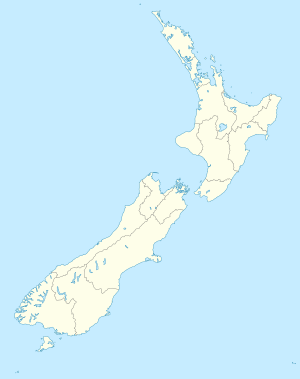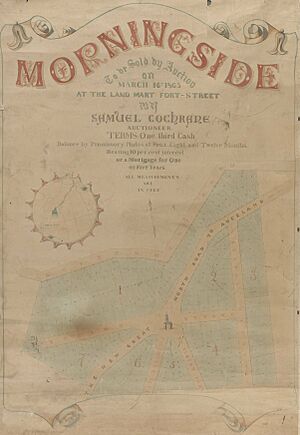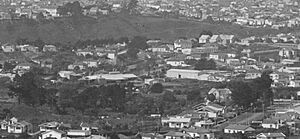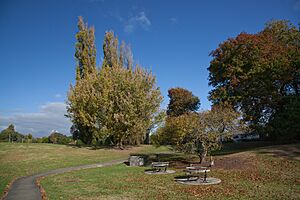Morningside, Auckland facts for kids
Quick facts for kids
Morningside
|
|
|---|---|
|
Suburb
|
|
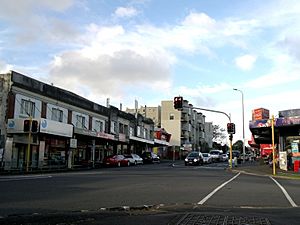
Morningside shops, as seen from the corner of New North Road and Morningside Drive.
|
|
| Country | New Zealand |
| Local authority | Auckland |
| Electoral ward | Albert-Eden-Puketāpapa ward |
| Local board | Albert-Eden Local Board |
| Area | |
| • Land | 109 ha (269 acre) |
| Population
(June 2023)
|
|
| • Total | 3,920 |
| Train station(s) | Morningside railway station |
|
|
||
Morningside is a suburb in Auckland, New Zealand. It is about four kilometres southwest of the city centre. It is also close to Eden Park and Western Springs Reserve.
Contents
Where is Morningside?
Morningside is located on the western side of the Auckland isthmus. This is the narrow strip of land connecting two larger landmasses. The suburb is south of the Northwestern Motorway. It is split by New North Road and the Western Line railway.
Morningside is surrounded by other suburbs. These include Grey Lynn, Kingsland, Sandringham, St Lukes, Mount Albert, and Point Chevalier.
Morningside's History
The area where Morningside is now was once swampland. Tāmaki Māori people called it Ngā Anawai. This name refers to the water-filled caves formed by lava flows. These lava caves were created over 30,000 years ago by volcanoes like Maungawhau / Mount Eden and Mount Albert.
On June 29, 1841, the Crown bought the Mount Albert area from Ngāti Whātua. This was part of a large 12,000-acre land sale. The land was rough, so it developed slower than other parts of Auckland. In the 1860s, New North Road was built. It provided a new way to access the area.
In March 1865, a man named Allan Kerr Taylor sold off a part of his land. He created a new village along the road. Kerr Taylor named it Morningside. He named it after a place in Scotland called Morningside, North Lanarkshire. His original plan for the village included a church. It was meant to be built on an island in the middle of New North Road.
The Morningside railway station opened in March 1880. This connected Morningside to Auckland city by train. Morningside grew slower than Kingsland, which was closer to the city. In March 1910, a new housing area called Shawville was sold in Morningside.
The suburb really started to grow after the tramline was extended to Morningside in 1912. This tramline ran along New North Road.
The heart of Morningside is its shops. They are located on New North Road, close to the railway station. One of the biggest buildings is a brick building from the 1920s. This building used to be the home of the Mount Albert Borough Council. Mount Albert joined with Auckland City in the late 1980s.
Morningside was also the setting for the animated TV show Bro'Town. It is also the hometown and album title for the musician Fazerdaze.
People of Morningside
Morningside covers about 1.09 square kilometres. In 2023, it had an estimated population of 3,609 people. This means there are about 3,311 people living in each square kilometre.
The population has changed over the years:
- 2006: 3,606 people
- 2013: 3,825 people
- 2018: 3,981 people
- 2023: 3,609 people
In the 2023 New Zealand census, there were 1,842 males, 1,743 females, and 24 people of other genders. The average age was 34.6 years. About 12.6% of the people were under 15 years old.
People in Morningside come from many different backgrounds:
- 69.7% European (Pākehā)
- 10.1% Māori
- 11.1% Pasifika
- 20.6% Asian
- 3.2% Middle Eastern, Latin American, and African New Zealanders (MELAA)
- 2.2% other ethnicities
Most people (95.6%) speak English. Other languages spoken include Māori (2.9%) and Samoan (2.9%). About 36.0% of people were born outside New Zealand.
Many people in Morningside have no religion (59.9%). Others follow different religions:
- 23.8% Christian
- 4.2% Hindu
- 1.7% Islam
- 1.7% Buddhist
- 2.3% other religions
Many adults in Morningside have a university degree or higher (45.3%). The average income was $56,100. Most people (63.8%) work full-time.
Things to See and Do
Morningside has several interesting places:
- The former Mount Albert Borough Council building.
- Fowlds Park: A public park where the Mount Albert Lions rugby league team plays. It is also home to the Auckland Irish Club.
- Morningside Church of Christ: This building opened in 1911 as the Wm. Moor Memorial Hall.
- Morningside village: This area includes the Morningside Precinct, which has many restaurants and is a popular place for events.
- School Reserve: This park was once the site of the Mount Albert Primary School from 1871 to 1940.
Education in Morningside
Mount Albert School is a primary school for students in years 1–6.
For older students, the local intermediate school is Kōwhai Intermediate School. The local secondary schools are Mount Albert Grammar School and Marist College.


